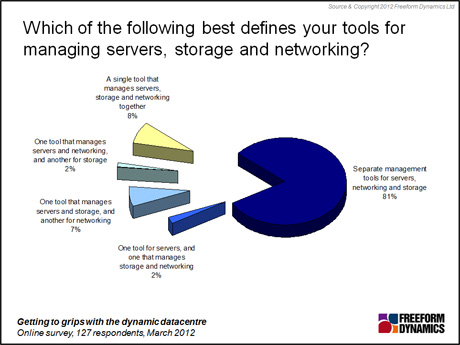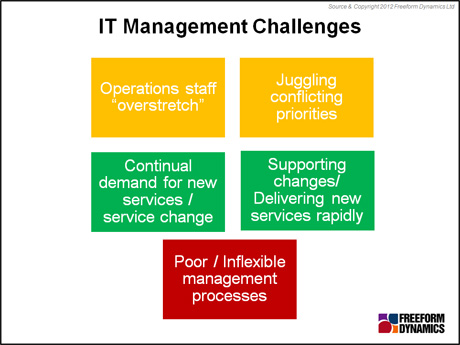Wonderful in theory, but few have it available
Going back, say, five or ten years, for many IT professionals managing IT systems came down to looking after the servers that ran business applications. Storage was pretty straightforward, mostly consisting of hard disks that, conveniently enough, were part of the server system itself. Networking, once it was functioning, was usually not too complicated to keep running. Most importantly of all, systems were usually fairly settled, and typically kept going for a few years with only limited need to “upgrade” hardware. OK, looking after the operating systems, middleware and applications stacks consumed considerable amounts of time, but the core hardware systems were fairly reliable.
But today, things have changed, especially when it comes to the expectations users and customers have of IT systems. Now almost every business system is expected to operate with good service quality and responsiveness, 24 hours a day, every day. Such expectations clearly have a major impact on how well IT staff have to monitor and manage all the components of systems that are today more complex than in the times illustrated above.
Indeed, as organisations have begun to virtualise servers, utilise networked storage systems and operate systems whose software components may be running on multiple devices, IT organisations increasingly need to have monitoring and management tools that allow them to administer everything as a whole, rather than rely on a multitude of tools that only integrate with each other via the brains and hands of IT staff. Tools that seek to provide manage multiple components of the IT landscape are often referred to as providing Unified Infrastructure Management (UIM) capabilities.

Figure 1
Figure 1, taken from a recent survey conducted by Freeform Dynamics (link : xxxx) illustrates just how fragmented are the management systems that IT professionals have to use as they seek to keep services functioning effectively. As can be seen, very few organisations have any great degree of integration between the various management tools that are in use. IT professionals readily acknowledge the challenges this fragmentation causes in daily operations, including the potential for manual error and security failings when staff have to use multiple tools serially to administer service delivery, never mind the large amount of time required to complete routine, repetitive tasks.
With the quality of IT service delivery becoming ever more critical to organisations, the problem of fragmented management tools raises several questions. Chief amongst these is “are things getting better?” We have regularly surveyed IT staff to gauge the state of play in this area and over the course of the last few years it is safe to say that very little has changed, despite business managers themselves recognising the growing dependence daily processes have on IT systems.
Our research over several years coupled with several decades of experience indicates several reasons why getting investment in management tools can be problematic. It is very clear that many people involved in IT budget approval processes do not understand the linkage between the use of appropriate systems management tools and the ability of the business to operate effectively. It is equally certain that few in IT have made a good job of articulating the business case for investing in systems management tools, let alone UIM.
It can also be argued that many IT professionals themselves have yet to realise the potential advantages of employing more tightly integrated management solutions that span large parts of the IT infrastructure. For example, when we ask “what are the major management challenges faced by IT organisations?”, we usually get a list that resembles that shown in figure 2. Many of these challenges are areas that better integration between management tools can help address, especially considering ways to administer entire IT services as a whole. Having to deal with each individual component, be it server, storage, networking or applications, in isolation adds complexity, time and increases the risk of service interruption.

Figure 2
But this state of affairs cannot carry on indefinitely, especially as IT systems complexity ramps up and as organisations endeavour to maximise their use of systems whilst minimising costs and risk exposure. With the pressure to deliver new services as well as to modify existing ones much more frequently than in the past, the importance of management tools is certain to grow.
We know that getting authorisation to ‘rip and replace’ any systems, IT or otherwise, is difficult if not impossible in all but exceptional circumstances. Thus data centre professionals will need to look at ways to improve their management capabilities step by step, but always with the view of bringing operations together. As ever though, investment in technology alone, especially management solutions, is never the whole story. To exploit integrated management tools effectively, much work will be required modifying operational processes and procedures, possibly also bringing different teams much closer together. There is scope in most organisations to improve IT service delivery with clear benefits for the business. Improving the understanding of IT management tools and their importance to business operations is a key first step.

Tony is an IT operations guru. As an ex-IT manager with an insatiable thirst for knowledge, his extensive vendor briefing agenda makes him one of the most well informed analysts in the industry, particularly on the diversity of solutions and approaches available to tackle key operational requirements. If you are a vendor talking about a new offering, be very careful about describing it to Tony as ‘unique’, because if it isn’t, he’ll probably know.





Have You Read This?
From Barcode Scanning to Smart Data Capture
Beyond the Barcode: Smart Data Capture
The Evolving Role of Converged Infrastructure in Modern IT
Evaluating the Potential of Hyper-Converged Storage
Kubernetes as an enterprise multi-cloud enabler
A CX perspective on the Contact Centre
Automation of SAP Master Data Management
Tackling the software skills crunch